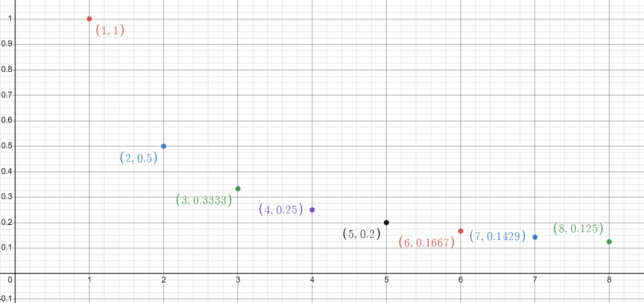The Harmonic Sequence
The harmonic sequence is a well-known mathematical sequence found in various fields. It is defined as the sequence of reciprocals of the natural numbers.
Definition
The harmonic sequence is defined by the formula \(a_n = \frac{1}{n}\), where \(n\) is a positive integer. The first few terms of the harmonic sequence are \(\frac{1}{1}, \frac{1}{2}, \frac{1}{3}, \frac{1}{4}, \ldots\).
Properties
- Non-Constant Difference: The difference between consecutive terms is not constant. For example, \(\frac{1}{2} – \frac{1}{1} = -\frac{1}{2}\), but \(\frac{1}{3} – \frac{1}{2} = -\frac{1}{6}\).
- Monotonic Decreasing: Each term is smaller than the previous term, so the sequence is decreasing. As \(n\) grows, the terms get closer to zero.
- Convergence to Zero: As \(n\) approaches infinity, the terms \(\frac{1}{n}\) approach zero. This means that the limit of the sequence is zero.
Graphical Representation
The graph of the harmonic sequence shows a curve that approaches zero as \(n\) increases. It can be represented by the function \(y = \frac{1}{x}\), where \(x\) is a positive integer.
Applications
The harmonic sequence has various applications, including in physics, music, and engineering, where it helps in understanding wave patterns, overtones, and electrical circuits.
Summary
The harmonic sequence is an essential mathematical concept with unique properties and wide-ranging applications. Its behavior, where the terms decrease but never reach zero, makes it a fascinating subject of study.

Dot Plot of the Sequence \( \frac{1}{n} \)
The dot plot of the sequence \( \frac{1}{n} \) for \( n = 1 \) to \( 8 \) shows a clear pattern of decay. As the value of \( n \) increases, the corresponding value of \( \frac{1}{n} \) decreases, approaching zero.
Specifically, the points plotted are:
- \( (1, 1) \)
- \( (2, \frac{1}{2}) \)
- \( (3, \frac{1}{3}) \)
- \( (4, \frac{1}{4}) \)
- \( (5, \frac{1}{5}) \)
- \( (6, \frac{1}{6}) \)
- \( (7, \frac{1}{7}) \)
- \( (8, \frac{1}{8}) \)
This pattern illustrates the fundamental property of the harmonic sequence, where each term is the reciprocal of its position in the sequence. The plot visually represents how the terms of the sequence get closer to zero as \( n \) increases, but never actually reach zero.
